

|
Soundclip:
|
| See Steve's Hand-Written Solo
Transcription |
|
Steve Khan's solo on: "Descarga Khanalonious"(Steve Khan) In the USA, the BGO Records(UK) release of the 3rd in a series of reissues of my recordings that span the late '70s, the early '80s, and now the mid-'90s happened on March 23rd, 2018. It is especially great because it follows on the heels of my most recent album, "BACKLOG"(Tone Center). 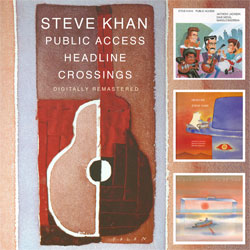 This new reissue embraces what I would refer to as the Eyewitness2 period from "PUBLIC ACCESS"('89) with Dave Weckl on drums; to "HEADLINE"('92) and finally "CROSSINGS"('94) both featuring Dennis Chambers on drums. The music on all of these albums represented a deepening of our music-making concepts, and the further exploration of feeling the presence of essential Latin elements in the music. "CROSSINGS" was probably the first full representation of that kind of expression. Yes, one could say that the ballads: "Pee Wee" and "Melancholee" had little or nothing to do with Latin music, and that would be true - but, the rest of music? It most certainly had Latin influences and feels. This new reissue embraces what I would refer to as the Eyewitness2 period from "PUBLIC ACCESS"('89) with Dave Weckl on drums; to "HEADLINE"('92) and finally "CROSSINGS"('94) both featuring Dennis Chambers on drums. The music on all of these albums represented a deepening of our music-making concepts, and the further exploration of feeling the presence of essential Latin elements in the music. "CROSSINGS" was probably the first full representation of that kind of expression. Yes, one could say that the ballads: "Pee Wee" and "Melancholee" had little or nothing to do with Latin music, and that would be true - but, the rest of music? It most certainly had Latin influences and feels.With this reissue release now in full bloom, I wanted to present something else from "CROSSINGS," and again, after some thought, I felt that the best way to represent the music that we had played then would be to share a transcription of the solo on my own composition "Descarga Khanalonious." To be perfectly honest, until recently, I really hadn't paid much attention to this particular solo. It doesn't matter where you might find yourself in the order of soloing, but believe me, whether you are forced to follow a Michael Brecker solo, or as it is in this case, to precede a Michael Brecker solo, the task is daunting, and likely as not, one is going to feel dwarfed by his immense presence, and the brilliance of his playing. Since this was recorded in 1993, that is exactly how I have felt. But now that I have been listening to this piece as a representation of one performance, I am feeling quite differently about it, and even a bit better than I had expected. I don't often feel that I have any kind of intuitive musical clock function when I'm playing. Some players, when improvising, especially over one-chord vamps or free sections, their playing exhibits a great sense of musical logic, and when all is assessed later, you find that their improvisation turned out to be a very logical representation of the number of bars. Until I transcribed this solo, I had no idea that I had actually improvised 64-bars, which, in the end, is like having played 2 choruses of a 32-bar standard. All these years later, it strikes me as remarkable. This solo, in its own way, represents so much of our group's style of music-making. None of this would have been possible without the intuitive and interactive brilliance of: Anthony Jackson(Contrabass Guitar), Dennis Chambers(Drums), and Manolo Badrena(Percussion). When "Descarga Khanalonious" was first composed, it really had 3 melodic sections. I labeled the Intro as [I] which featured Anthony and Manolo, and eventually they were joined by Dennis. When the guitar enters, I played a chordal melody section which was labeled as [A]. Both of these sections were centered around G7. Then, a single-note line melody enters, and that section was labeled as [B]. After repeating both [A]-[B], we moved on to a new section which was labeled as [C], and here the harmonic center shifted to Eb7. As that section ends, there is a brief 4-bar reprise labeled as [B2], and then we move into the guitar solo [D], which is played over the same G7 area. As the solo comes to its conclusion, once again, those same 4 melody bars are reprised as letter [B2], and then, the 1st 4 bars of [C] are used to give Michael Brecker a nice "ramp" into his solo which is centered around Eb7. For the purposes of discussing the guitar solo section, I have labeled all the sections just as they appeared on the lead sheet. When one is attempting to play some form of Latin music, in this case, some kind of Latin Jazz Fusion, paying attention to the all important clave becomes crucial. After listening carefully to the 3 melodic sections, it was my sense that [A] was in 3:2 clave, and [B] felt best to me in 2:3 clave. Then, [C] returns to 3:2 clave. If one was to strictly adhere to this, there would have be some bars added or subtracted to keep the clave from being broken. Of course, back then, I wasn't even aware of these things and their traditional importance. Before presenting this here, I went to my usual source of rhythmic wisdom and contact the great Venezuelan saxophonist/composer/arranger, long-time member of Guaco, Rafael Greco. After much thought on his part, he actually concurred with my assessment, but hastened to add that, he felt that it would perfectly fine to just play the entire piece in 3:2 clave, and not worry about changing things going in and out of letter [B]. Rafa pointed out to me that, our dear Manolo Badrena on his cowbells was actually playing "a kind of Mozambique à la Manolo, and in an instinctive way, he makes the clave in 3:2, which says a lot about his personal roots and traditions. In such a case, it is preferable that Manolo made the decision." I hope that this explanation is both helpful and instructional. Obviously, each player has his/her own way of thinking about soloing, especially when it is over a one chord pedal. One could certainly just shred away, and go for it - and that approach might turn out fine. 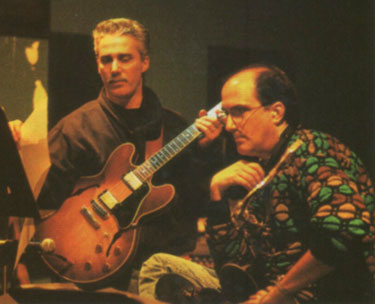 However, for me, I always like to remain connected to melodic material that has come before, or was even presented during various melody sections. in this case as the original [B] single-note melody section is rich with linear ideas, I chose to explore those very things. As we go along, I will try to point them out. However, for me, I always like to remain connected to melodic material that has come before, or was even presented during various melody sections. in this case as the original [B] single-note melody section is rich with linear ideas, I chose to explore those very things. As we go along, I will try to point them out.As they appear in the melody sections, many of the lines or phrases begin on the and-of-4, and that is exactly what I do going into bar 1 of the solo. The opening phrase very much mirrors the 1st main melodic line, and during the 1st 8 bars, everything remains very much consonant and, over G7, I am really employing the D Dorian mode [D, E, F, G, A, B, C]. The first hint, that the lines will touch upon extensions and motifs that venture outside the normal bounds of modal playing, appears at the end of bar 11 where you see that I played a C#(b5) and then down a 6th to an E-natural. The next idea that stretches the harmonic scope comes in bar 15 with two 3-note chordal punctuations that are most common to my style of playing. You see that G, our root, stays on top of both voicings, and 4ths within move up from A-D to Bb-Eb, and, in doing so, suddenly it sounds like we have gone briefly to a Cm7/G area. Bar 17 begins with a linear configuration that I often like to employ, and that is to surround the target note, in this case D-natural, with both its chromatic upper and lower neighbors(Eb-Db). That very brief inference then takes me in the following bar to using a Db triad [Db(b5), F(7th), Ab(b9)] before eventually finding myself right back in the area of G7 in bars 19-20. The phrase is then answered by further chordal punctuations, this time with F-natural on top and the same 1/2-step movement below heading upwards in 4ths. Rhythmically speaking, notice how the placement of those punctuations shifts from the and-of-3 to the and-of-2, to the and-of-1, and finally to the and-of- 4. As I head into bar 25, I would say that this new harmonic area has me doing one of two things, [1] relating to it as Bb Dorian [Bb, C, Db, Eb, F, G, Ab], or perhaps using the minor pentatonic built upon the #9 which gives us ALL of the altered tones. That would be Bb minor pentatonic [Bb(#9), Db(b5), Eb(#5), F, Ab(b9)]. You will see and hear a lot of chromatic neighboring tones being put to good use, with examples being the E-naturals in bar 26, or the Gb's that you see in bars 26 and 28. in bars 31-32, there is clearly more of a sense of Bb Dorian - even with a Gb thrown-in in bar 31. This takes us 1/2-way through the solo. The last 2 beats of bar 32 really serve as the beginning of the next section. You will notice that I am playing an F-natural but using alternate fingerings (+) to give it a more unique quality and perhaps even a greater sense of swing, even if we are playing within an even 8th-note feel. Those single-note F's are answered by chordal punctuations, and again, the presence of Bb-Eb in the 1st voicing of bar 32 gives that sense of Cm7. Then in bars 35-36, we venture into new territory as we pass through Ab7(13) before landing back on the guide tones(F-B) for G7. After a welcome breath in bar 37, the line outlines G7(13b9), and as the full phrase reveals itself, you find that there are more Db's, Bb's, and Ab's. All of these notes are tones outside the bounds of D Dorian. 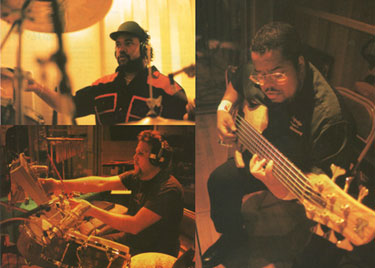 Finally, at the end of bar 43, a sense of the consonant returns with the E-natural to F-natural, and then another breath, always a good thing. I have to say that, to this point in the solo, Anthony Jackson has been very, very sparse in his approach, almost as if we had all agreed that most of the solo section would be guitar, drums and percussion. Honestly, I don't know that I recall such a discussion for this particular solo section. Finally, at the end of bar 43, a sense of the consonant returns with the E-natural to F-natural, and then another breath, always a good thing. I have to say that, to this point in the solo, Anthony Jackson has been very, very sparse in his approach, almost as if we had all agreed that most of the solo section would be guitar, drums and percussion. Honestly, I don't know that I recall such a discussion for this particular solo section.At bar 45, in sharp contrast to everything that has appeared in the solo thus far, the first real 4-note voicings appear, and the scope of the harmonies begin to expand even further. One of the principles that has become a staple in my own approach to playing is that, there is no difference in linear importance between a single-note line and the top-most voice of any chord! This, to me, is essential! So, in a passage like this, no matter what is going on beneath those top voices, the highest notes are still right around the G7 area, especially if you just consider the Bb to be a blue note. Notice how Anthony plays a big Db on the and-of-3 just before the chords come in. This is a spectacular moment. In bars 48-49, once again our principal [B] melodic fragment is alluded to while soloing. In bars 50-52, you have a sequence of descending whole-steps and 6ths that take us through both G7 and Db7. As the solo is winding down, at bar 53, there is the longest linear passage within the entire solo. Upon closer examination, there are moments when I am venturing outside of the tonal center, but this is only a device to create "tension" that must be "released" if the solo is to be considered a success! One of my favorite moments within this long line begins in bar 58, where I play a rather traditional ascending line in D Dorian, but as it hits the high C-natural, it then descends through a sequential idea: Bb-G-F-Eb, which looks very much like Eb major pentatonic [Eb, F, G, Bb, C] which then travels down a whole-step to Db major pentatonic [Db,Eb, F, Ab, Bb], and on the last 2 beats of bar 60, I am playing Ab minor pentatonic [Ab, Cb, Db, Eb, Gb]. This brief journey resolves on beat 1 of bar 61 with a B-natural descending down a 6th to D-natural, both notes are most consonant with G7. From the end of bar 61, the chords extend outwards from a G7(13) to those same movements that we've seen throughout this solo, made all the more believable because of the usage of the common tone on top. The solo ends with a held Cm7 voicing (Bb-Eb-G). From an old classical music principal, this makes perfect sense as Cm would be considered the essential part of any plagal cadence(iv-I). Here, it would be Cm7 to G7 which is very, very common. I would like to point you in the direction of the "Descarga Khanalonious" LEAD SHEETS which I just decided to re-write and post here at the website for the very first time. As the site was first getting launched in 1998, and one year later I was a co-leader of the Caribbean Jazz Project alongside Dave Samuels and Dave Valentín, we recorded a version of this tune, but it was retitled "Descarga Canelón" and appeared on our CD, "NEW HORIZONS"(Concord Picante) in 1999. Because of the constant shifts in the melodic rhythms of the various sections of the original, bassist John Benitez was concerned about the clave problems and so, in order to solve those issues, some bars had to be deleted here and there, especially in the [C] sections. Honestly, I don't know that there was ever a really completely musical solution to this, but we tried our best. As I often do, when writing out new lead sheets, I try to listen carefully to what Anthony Jackson actually played on the bass and include some his incredible personal touches on the lead sheet. You will see those things if you choose to follow along. Pay special attention to what he played in bars 13-16 of [C], it is quite remarkable. Looking at these particular lead sheets, I am again struck by the changes to my music writing "hand" over the past 25 years, or longer, and I see a great improvement. Just look at the difference between the lead sheets and the solo transcription. Of course, every so often, someone will write to me and complain that I am not using Finale or Sibelius, but, as I always explain, I just enjoy doing them by hand. My apologies to those who continue to be upset with me about this. As "CROSSINGS" was recorded in 1994, that was 4 years before I even had my first computer!!! Yes, I am and was a dinosaur - too damn slow to adapt! And, of course, this was pretty much before digital recording programs like ProTools, released in 1989, had become standard at most studios! In other words, musicians could punch-in and repair little errors here and there, but, doing things like punching-in an entire drum kit could become risky beyond belief. To preface my point of this story, I want to say that I love and respect Dennis Chambers as much as anyone I've ever worked with and become friends with in my life. He's one of the greatest living drummers ever!!! As Dennis has shared in countless interviews, he doesn't read music, and he learns all of the complex music that he has ever performed by listening to beautifully prepared demos, or perhaps live performance recordings. He studies what he is given, and arrives at the rehearsal or the studio better prepared than anyone else - sometimes even the artist! The problem, of course, can be that if a last minute change is necessary - everyone else can just get out a pencil and add 2 extras bars before [C]. But Dennis won't know what we're talking about, and when those bars return, he's going to be thrown off and lost. It can become difficult and requires further rehearsing. If you look at the lead sheet for "Descarga Khanalonious" you will see that there are lots of little accents to catch, especially during letters [B] and [C]. If you listen to the performance, you can hear that Dennis played some of them and missed others. What does one do in a case like this? Do you keep doing take after take after take? For me, no way! You just have to live with these minor imperfections! My philosophy has always been that you can't ask great musicians, especially great drummers to just keep doing takes! Look at it this way, if you know this piece, how could I ask Michael Brecker to do more solos just because of a few missed accents? To me, one has to be mentally and spiritually prepared to play something of some depth within the first 2 takes, and that's it!!! One other strange little oddity that can occur with Dennis' work method is that, this piece was modeled on Cal Tjader's "Descarga Cubana" from his 1966 album "SOUL BURST"(Verve). So, I gave Dennis a cassette of that tune and asked him to learn the cymbal bell pattern. Well, he learned it, but he took the whole thing so literally that, if you will notice, he didn't even hit his bass drum once during the melody - because? He thought that that was what I wanted. If you can believe this, I didn't even notice that detail until years later!!! Crazy, right? One element that some of you might find interesting is about my guitar sound on this recording. For years after "CROSSINGS" was recorded, I had come to feel that the sound, both my individual sound and our group, crafted by the great engineer, James Farber at Skyline's 6th Floor Studio was the best audio sound that I had ever achieved 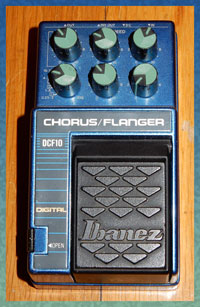 - at least until the recent albums: "PARTING SHOT"(2011); "SUBTEXT"(2014); and most recently "BACKLOG"(2014).This process of the search for a sound really took shape after I had recorded "PUBLIC ACCESS"(1989) and for that entire album, I had used my Bob Bradshaw constructed rack that was about the size of a refrigerator. But, after that album, it wasn't too hard to realize that I would never ever be able to tour with that rack, much less do anything locally either. So, when I sadly had to change formats and went back to playing trio with acoustic bass and drums, my set-up completely changed as well. I don't actually recall when or how it happened, but I know that there was a moment when I fished out my Ibanez DCF-10 - Digital Chorus/Flanger pedal and gave it try - for some insane reason, that was the moment when everything seemed to come together for me! I don't know what it is about this particular "analog" pedal that does this, but when one is playing single-note lines, you barely hear the chorusing effect, but as soon as you play a chord voicing, the pedal seems to open-up and you hear the effect. I began using this pedal on "LET'S CALL THIS"(1991) and the carried forward to "HEADLINE"(1992) and then "CROSSINGS" and into the future, right up to the present!!! As I searched for the perfect balance with this pedal, you can hear that the intensity of the effect became less and less, and less with each successive recording. During the past 10 years of work, it has become less than ever before - and I'm more happy with my sound than ever before! To help those curious, I decided to take a photo of one of my spare DCF-10 pedals with the settings that used for "BACKLOG." If you would like to have them with a bit more precision, please take a moment to visit my EQUIPMENT page, and everything is detailed right there!!! I would tell you that, as the years have come and gone, what I have tended to do is to continue to back-off on the WIDTH and the SPEED controls, moving both of them incrementally to the left. - at least until the recent albums: "PARTING SHOT"(2011); "SUBTEXT"(2014); and most recently "BACKLOG"(2014).This process of the search for a sound really took shape after I had recorded "PUBLIC ACCESS"(1989) and for that entire album, I had used my Bob Bradshaw constructed rack that was about the size of a refrigerator. But, after that album, it wasn't too hard to realize that I would never ever be able to tour with that rack, much less do anything locally either. So, when I sadly had to change formats and went back to playing trio with acoustic bass and drums, my set-up completely changed as well. I don't actually recall when or how it happened, but I know that there was a moment when I fished out my Ibanez DCF-10 - Digital Chorus/Flanger pedal and gave it try - for some insane reason, that was the moment when everything seemed to come together for me! I don't know what it is about this particular "analog" pedal that does this, but when one is playing single-note lines, you barely hear the chorusing effect, but as soon as you play a chord voicing, the pedal seems to open-up and you hear the effect. I began using this pedal on "LET'S CALL THIS"(1991) and the carried forward to "HEADLINE"(1992) and then "CROSSINGS" and into the future, right up to the present!!! As I searched for the perfect balance with this pedal, you can hear that the intensity of the effect became less and less, and less with each successive recording. During the past 10 years of work, it has become less than ever before - and I'm more happy with my sound than ever before! To help those curious, I decided to take a photo of one of my spare DCF-10 pedals with the settings that used for "BACKLOG." If you would like to have them with a bit more precision, please take a moment to visit my EQUIPMENT page, and everything is detailed right there!!! I would tell you that, as the years have come and gone, what I have tended to do is to continue to back-off on the WIDTH and the SPEED controls, moving both of them incrementally to the left.Last month, we presented my solo over Thelonious Monk's "Think of One" it still bears noting that now even with this transcription presentation, the only other solo to be presented here at KORNER 1 from "CROSSINGS" was Michael Brecker's tenor sax solo that appears on Cole Porter's "I Love Paris." 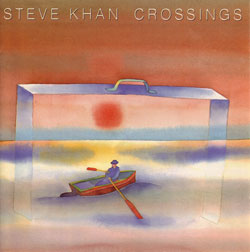 It remains as one of the great moments on the album and, for those who are not familiar with it, the interplay during the fade is worth the price of admission. Anthony Jackson and Mike take a simple Cm7 montuno to unimagined places - places that even surprised me. Please take the time to investigate it. On another related note, just a couple of months after "CROSSINGS" was recorded, Anthony, Dennis and I went on another European tour, and on the last night of the tour we did a live radio broadcast for WDR in Köln, Germany. What happened after that night's performance and broadcast is pretty remarkable, and some 14 years later, the recording of that very broadcast went on to become the double CD album, "THE SUITCASE." Just follow the link, and you can read all about it. It must be noted that, the only reason that Manolo Badrena did not accompany us on that tour, and many others, was that sadly there just wasn't enough money in the budget to accommodate him. This is something that I will always regret. It is a financial reality that many small musicians like me face. It remains as one of the great moments on the album and, for those who are not familiar with it, the interplay during the fade is worth the price of admission. Anthony Jackson and Mike take a simple Cm7 montuno to unimagined places - places that even surprised me. Please take the time to investigate it. On another related note, just a couple of months after "CROSSINGS" was recorded, Anthony, Dennis and I went on another European tour, and on the last night of the tour we did a live radio broadcast for WDR in Köln, Germany. What happened after that night's performance and broadcast is pretty remarkable, and some 14 years later, the recording of that very broadcast went on to become the double CD album, "THE SUITCASE." Just follow the link, and you can read all about it. It must be noted that, the only reason that Manolo Badrena did not accompany us on that tour, and many others, was that sadly there just wasn't enough money in the budget to accommodate him. This is something that I will always regret. It is a financial reality that many small musicians like me face.I am so very grateful to BGO Records for doing this reissue, it has really lifted my spirits after a most difficult year in 2017. So, here we are, having arrived at April, 2018, and the weather in the northeast seems to be warming-up a bit, baseball season has finally arrived, but our political climate in Washington, DC becomes more insane with every passing day. Like everyone else who cares deeply about our country, I have no idea where this is all headed, where things are going to end up, but also like a certain segment of the population, I have felt embarrassed and ashamed of the comportment of our president. We'll see where this all goes. As it is with all things, they have beginnings and endings! In the meantime, here's wishing all those who visit these pages a very happy springtime!!!
[Photos: Michael Brecker - Steve Khan
Dennis Chambers-Anthony Jackson-Manolo Badrena Collage Photos by: David Tan @ Skyline Studios, December 29-30, 1993] |